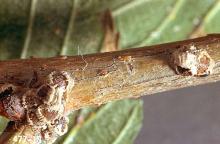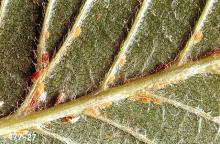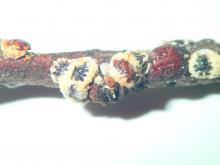Gossyparia spuria
Pest description and damage Scale insects are small (less than 0.125 inch in length) soft insects that live beneath waxy scales. These insects are often identified by the shape and size of their scales, the description of adult males and females, immature crawler stage, color of eggs, and host plant preferences. The European elm scale insect is a reddish-brown to purplish scale surrounded by a conspicuous fringe of white, waxy material. They sometimes resemble mealybugs. The mature females are about 0.4 inch in diameter. The crawlers emerge in late spring and summer and are yellowish to dark brown. This scale feeds on twigs and branches as well as leaves. Feeding scales produce honeydew, a sweet, sticky material that attracts honeydew-feeding ants and honeydew and becomes covered with a growth of black sooty mold. Infested trees may show yellowing leaves and early leaf drop, followed by death of twigs and branches. Severe infestations may cause extensive damage.
Biology and life history These scales overwinter as immature crawlers in bark crevices of small branches and branch axils. In spring, the females lay eggs and by June, the crawlers are active. They move to the undersides of leaves to feed, remaining there all summer. Often, the scales drop to the ground with the normal leaf-fall and die. There is one generation per year.
Management-cultural control
Asiatic elms such as Chinese elm (Ulmus parvifolia) are not infested. Siberian elm (U. pumila) is also resistant but is a poor shade tree. Provide proper culture to maintain plant health. Healthy trees are more able to tolerate scale infestations. Prune and destroy twigs to help control isolated infestations, when practical. Apply adhesive tape, double-sided or sticky side out, near infestations of adult scales to catch the crawler stage. As with aphids, avoid excessive nitrogen fertilizer, as this favors population increase.
Management-biological control
Natural enemies such as lady beetles, green lacewings and wasp parasitoids help control scale populations.
Management-chemical control
Avoid use of broad-spectrum insecticides that kill beneficial insects.
Dormant-season spray-Apply with enough water to cover the entire tree thoroughly.
Growing-season spray-Apply to control the immature crawler stage, usually in late spring to early summer. Scout for crawlers and gather life history data.
See Table 1 in:
Chemical Control of Landscape Pests
For more information
See "Scale insect" in




